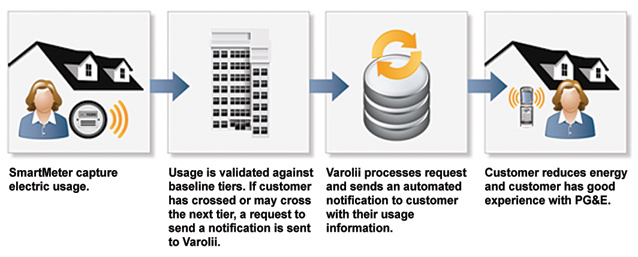The United States government continues to ramp up its investment in the modernization of our country's energy grid system. The recent federal stimulus package included a $3.4 billion grant to incent private companies, utilities and manufacturers to develop and install technologies that will transform today's grid into a smarter, stronger and more reliable electrical system. In turn, a smarter system will empower consumers to monitor their consumption, reduce their demand and ultimately conserve precious energy resources.

Victor Jimenez
Strategic Planning
and Architecture
Pacific Gas & Electric

Kael Kelly
Senior Director
Varolii
As utilities consider how best to leverage various Smart Grid technologies ranging from improved grid infrastructure to in-home smart meters, they can’t overlook an essential component of a successful transition that has nothing to do with the technology: ensuring consumer support. Making consumers better aware of Smart Grid is the first step. And then proactively educating them about the positive impact that a Smart Grid system will have on reducing their energy consumption and how it will place more control in their hands are the keys to getting consumers on board with the new program.
For the most part, consumers like the underlying idea of a Smart Grid. According to a recent Harris Interactive research poll, a majority of U.S. adults (57 percent) are aware of how much electricity they are currently consuming, and an even greater number (67 percent) say they would reduce their energy usage if they had visibility into it. A fundamental promise of smart meters is to provide continuous consumption feedback to consumers. This is critical because someday, as a standard practice, meter rates could be tied to the cost to produce electricity, which rises during peak hours. If this type of pricing replaces the current flat rate pricing, 75 percent of Americans would “want to be able to see and control how much electricity” they are using, according to the survey.
Just as people like to see the calls and text messages they’re being charged for on their phone bill, knowing how much electricity they’re consuming gives customers control over their use and how much money they’re spending. According to Oracle’s 2009 online survey of U.S. energy consumers, an estimated 95 percent of Americans say they are interested in receiving information about their energy consumption from their utility provider. However, not all consumers realize they can (or soon will have) this kind of real-time visibility into their consumption rates – let alone that their utility providers are even making major technological investments to overlay the conventional energy system.
According to the Harris Interactive research poll, 68 percent of Americans haven’t heard of Smart Grid and 63 percent haven’t heard of smart meters. This low level of awareness implies that consumers may not know the long-term benefits of a Smart Grid system and will be less willing to initially pay higher premiums associated with the technology upgrades.
Consumer Awareness and Education Starts with Providing Reasons for a Smart Grid
Our nation’s electric infrastructure is rapidly running up against its own limitations, according to the U.S. Department of Energy. The risks associated with relying on an often-overtaxed grid grow more complex every day. Emerging challenges, such as security and the effects of climate change, make system transformation necessary. However, not all consumers are aware of the reasons why our country needs a new energy system.
The first step utilities need to consider before implementing a Smart Grid program is to educate consumers on why making the investment today is critical for seeing benefits tomorrow. For example, one way that utilities can convey this message is by posting the following reasons for a new energy system on their websites or as a bill insert:
- Bloated Energy Demand – Since the early 1980s, peak demand for electricity exceed transmission growth by nearly 25 percent every year due to a growing population, bigger homes and more advanced appliances. And, during peak consumption hours, power and distribution centers face a virtual traffic jam of consumers using massive amounts of energy at the same exact time.
- Aging Infrastructure – The power grid is nearly a century old; it is becoming increasingly frail due to rising energy demands and limited visibility into grid operations. As expressed by the Office of Electricity Delivery and Energy Reliability, “…the U.S. electrical grid, once the envy of the world, is no longer world class [and] remains bogged down with mid- 20th century technology.”
- Minimal Funding – Even with a clear need for upgrading the grid, the portion of utilities’ revenues that are spent on research and development is the lowest of all industries (less than 2 percent). In order to make any change at all, all parties involved in our nation’s energy consumption, including the government and consumers, need to make initial investments to see any progress.
- Pricing Spikes – As states remove rate caps and the cost of electricity multiplies, consumers are seeing their power bills increase with little information on how to combat rising costs. With a Smart Grid system, consumers will be able to see real-time usage and pricing information, giving them the opportunity to immediately alter their rate of consumption and ultimately, save money.
- Exacerbated Outages – More outages are occurring due to the slow response times of mechanical switches, lack of automated analytics and lack of visibility into the existing grid infrastructure. In fact, there have been five massive blackouts in the past 40 years, three of which occurred in the past nine years. An upgraded grid will improve energy efficiency and reduce outage occurrences that can cost businesses millions of dollars in recovery and lost revenue today.
- Environmental Awareness – If the current grid were just 5 percent more efficient, the energy savings would equate to permanently eliminating the fuel and greenhouse gas emissions from 53 million cars. The new grid system will not only save energy, but it will incorporate technology applications that allow easier integration and higher penetration of renewable energies.
Smart Grid Success Depends on Consumer Support
The key to convincing consumers that Smart Grid is a worthwhile investment is to proactively educate them about what changes to expect and the specific benefits they will see on a daily basis. Getting program information in front of them before making major service and pricing changes will ultimately impact the success of the program. The benefits to consumers include:
- More accurate and timely billing;
- Better energy consumption information to understand and manage their bills;
- Faster outage notifications and restoration times;
- More energy efficiency and demand response programs to help lower costs;
- Reduced inconvenience associated with meter reads and service turn-on and shut-off.
Lessons Learned About Smart Grid Education Programs
There have been several cases where North American utilities did not proactively communicate with their customers about fundamental elements of Smart Grid programs, such as the installation of smart meters, and suffered consumer backlash as a result. By not informing their customers, these utilities suffered a spike in complaints to the Public Utilities Commission because electric bills soared right after the meters were installed. The lack of consumer education and ongoing communication can make for a turbulent start to these Smart Grid program roll-outs.
And, the government is recognizing the importance of upfront communications. For example, Baltimore Gas & Electric’s (BG&E) proposal to install 1.2 million smart meters was initially rejected by Maryland’s Public Service Commission, in part, because the BG&E proposal contained no detailed customer education plan or messaging to drive the new behavioral changes required to make the transition. The commission’s decision also noted that any Time-of-Use pricing scheme would need an even savvier education plan for customers to comply with the program.
In contrast, a Canadian utility took a more proactive approach by communicating with its customers prior to smart meter installations, letting them know exactly what to expect and how they could save money on Timeof- Use rates.
Several months after the meters were installed, and after several reminders, they placed all residential customers on a voluntary Time-of-Use rate program, and allowed customers to opt out if they chose to do so. As customers saw concrete, daily benefits from their smart meters, they reacted positively towards the program.
Usage Notifications Eliminate the Surprise Factor
In the past, the utilities industry has relied on direct mail and door-to-door task forces to spread awareness about changes to services or new program offerings. Typically, utilities experience a low response rate to these basic communication initiatives. It is clear that if utilities want to spread the word about their Smart Grid programs and ensure customer enrollment, a smarter communications strategy will be required.
Today, more progressive utilities are turning to automated and interactive communications via multiple channels, such as voice, text messages and email, to send customers information about upcoming changes and the benefits associated with new programs. Several are even using automated communications to send customers ongoing usage alerts, giving them more frequent information about their energy consumption to help them think about scaling back.
Previously, this type of information was not available with older meters that were read on a monthly basis. Also, utilities are starting to use automated communications for their demand side management programs to provide their customers with timely information about curtailment events or time-sensitive programs.
Pacific Gas & Electric (PG&E), a regional utility serving 15 million people, recently implemented a Smart Grid automated communications program. The utility sends residential customers who have electric smart meters an automated alert when their usage has either crossed or is approaching the threshold for a higher payment tier. The early results are encouraging as most customers were previously not aware of their usage tiers, and the information was not available with legacy meters. PG&E expects most customers will respond to the increased awareness of their usage habits by reducing their energy consumption and/or exploring alternative rates or programs.

Automated communications have helped PG&E provide even better service to customers at a fraction of the cost of direct mail and door-to-door task forces. Additionally, the automated communications deflect inbound calls into the utility’s contact center by anticipating questions customers may have and proactively sending them information to address their concerns. In turn, the utility’s contact center agents can focus on the customers who have more serious service issues and require immediate assistance.
Early and Frequent Communication Ensures Program Success
Smart Grid programs are rapidly picking up steam. In fact, more than 8 million smart meters have already been installed throughout the United States, and an additional 50 million are expected to be in use by 2015 (according to a list of publicly announced projects kept by The Edison Foundation). While this increase suggests a fast and inevitable transition to a national Smart Grid, consumers must be on board with it. However, experts point out that consumer cost-sensitivity is one of the biggest challenges to overcome. While many agree about the benefits of tomorrow’s utility grid, in the present economy, consumers are still reluctant to pay for anything they don’t deem a vital necessity.
It’s essential for utilities to communicate early and often with their customers about Smart Grid programs before and during implementation. Consumers must be fully aware of the changes to expect and the immediate and long-term benefits they will experience. Proactive education and transparent communication will allow adoption of the new program to be far more successful and help utilities drive higher customer satisfaction levels.
About the Authors
Victor Jimenez is a Business Solution Architect in PG&E’s Strategic Planning and Architecture organization where he designs strategic technology solutions for complex business problems. Jimenez has over 25 years of IT experience and 14 years of utility experience with expertise in meter-to-cash, demand side management, integration, and enterprise architecture.
Kael Kelly is a senior director for Varolii Corporation where he directs the company’s product marketing strategy and team. He brings more than 10 years of experience translating customer needs and market data into building successful products and services. His background in product development and management of the entire marketing mix covers a broad spectrum of industries. Prior to joining Varolii, Kelly was Product Manager at Onvia.com where he led the company’s site requirements, development and customer research.







